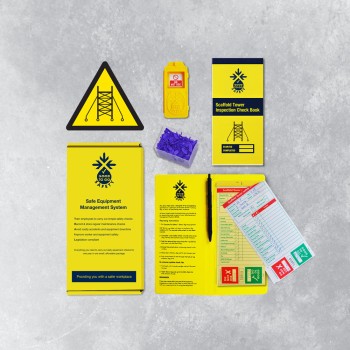We're extremely sad to report that a employee has died due to falling from a misconfigured scaffold tower.
Cambridge Magistrates Court heard how, on 15 September 2017, Sean Harding was working on a mobile tower levelling a steel beam that was seated on a door lintel. This involved using a crowbar to lever the beam up for a work colleague to insert a metal packer into the gap. Mr Harding caught his jacket sleeve on the tower, lost balance and fell over a single guard rail and down to ground level. He was taken to hospital but died three months later due to medical complications.
An investigation by Health and Safety Executive (HSE) found that the mobile tower wasn’t configured correctly for the task due to the limited headroom and that double guard rails could have been used, if configured correctly.
Peter Saunders Builders Ltd of Tennyson House, Cambridge Business Park, Cambridge pleaded guilty to breaching Regulation 8 (a) of the Work at Height Regulations 2005 and was fined £16,000 with £5,139.80 costs.
Speaking after the hearing, HSE inspector Stephen Hartley said, “Falls from height remain one of the most common causes of work-related fatalities in this country and the risks associated with working at height are well known.
“Those in control of work have a responsibility to select access equipment that is suitable for the task and the work environment and ensure that it is safely used.”
Asking employees to conduct pre-use inspections before using scaffold towers is a smart and responsible policy to enforce. With our easy-to-use walk-through checklist it only takes a short time to ensure that a scaffold tower is safe to operate. Not only will it provide protection for the company and workers, but it also reinforces a strong safety awareness message at management level.
Cambridge Magistrates Court heard how, on 15 September 2017, Sean Harding was working on a mobile tower levelling a steel beam that was seated on a door lintel. This involved using a crowbar to lever the beam up for a work colleague to insert a metal packer into the gap. Mr Harding caught his jacket sleeve on the tower, lost balance and fell over a single guard rail and down to ground level. He was taken to hospital but died three months later due to medical complications.
An investigation by Health and Safety Executive (HSE) found that the mobile tower wasn’t configured correctly for the task due to the limited headroom and that double guard rails could have been used, if configured correctly.
Peter Saunders Builders Ltd of Tennyson House, Cambridge Business Park, Cambridge pleaded guilty to breaching Regulation 8 (a) of the Work at Height Regulations 2005 and was fined £16,000 with £5,139.80 costs.
Speaking after the hearing, HSE inspector Stephen Hartley said, “Falls from height remain one of the most common causes of work-related fatalities in this country and the risks associated with working at height are well known.
“Those in control of work have a responsibility to select access equipment that is suitable for the task and the work environment and ensure that it is safely used.”
Asking employees to conduct pre-use inspections before using scaffold towers is a smart and responsible policy to enforce. With our easy-to-use walk-through checklist it only takes a short time to ensure that a scaffold tower is safe to operate. Not only will it provide protection for the company and workers, but it also reinforces a strong safety awareness message at management level.






